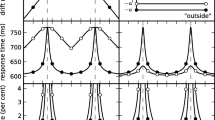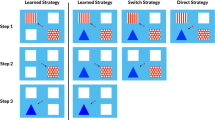Abstract
We report the results of a 4-year-long study of capuchin monkeys (Cebus apella ) on concurrent three-way classification and linear size seriation tasks using explicit ordering procedures, requiring subjects to select icons displayed on touch screens rather than manipulate and sort actual objects into groups. The results indicate that C. apella is competent to classify nine items concurrently, first into three disjoint classes where class exemplars are identical to one another, then into three reciprocal classes which share common exemplar (size) features. In the final phase we compare the relative efficiency of executive control under conditions where both hierarchical and/or linear organization can be utilized. Whilst this shows a superiority of categorical based size seriation for a nine item test set suggesting an adaptive advantage for hierarchical over linear organization, Cebus nevertheless achieved high levels of principled linear size seriation with sequence lengths not normally achieved by children below the age of six years.






Similar content being viewed by others
References
Anderson JR (1990) The adaptive character of thought. Erlbaum, Hillsdale
Boysen ST, Bernson GG, Shreyer TA, Quigley (1993) Processing of ordinality and transitivity by chimpanzees (Pan troglodytes). J Comp Psychol 107:208–215
Brainerd C, Reyna VF (1990) Gist is the grist: fuzzy trace theory and the new intuitionism. Dev Rev 10:3–47
Brannon EM, Terrace H (1998) Ordering of the numerosities 1–9 by monkeys. Science 282:746–749
Byrne RW, Russon AE (1998) Learning by imitation: a hierarchical approach. Behav Brain Sci 21:667–709
Chalmers M, McGonigle B (1984) Are children any more logical than monkeys on the five term series problem? J Exp Child Psychol 37:355–377
Cheney DL, Seyfarth RM (1990) How monkeys see the world: inside the mind of another species. University of Chicago Press, Chicago
Clark HH, Clark EV (1977) Psychology and language. Harcourt, New York
Conway CM, Christiansen MH (2001) Sequential learning in non-human primates. Trends Cogn Sci 5:539–546
D'Amato MR, Colombo M (1989) Serial learning with wild card items by monkeys (Cebus apella): implications for knowledge of ordinal position. J Comp Psychol 15:252–262
DeLillo C, McGonigle B (1999) The logic of searches in children and monkeys. Int J Comp Psychol 10:1-24
Fragaszy DM, Johnson-Pynn J, Hirsh E, Brake KE (2002) Strategic navigation of two-dimensional alley mazes: comparing capuchin monkeys and chimpanzees. Animal Cognition DOI 10.1007/s10071-002-0137-8
Gillan DJ (1982) Reasoning in the chimpanzee: II. transitive inference. J Exp Psychol 7:150–164
Greenfield PM, Nelson K, Saltzman E (1972) Development of rulebound strategies for manipulating seriable nesting cups: a parallel between action and grammar. Cogn Psychol 3:291–310
Hara K, Warren JM (1961) Stimulus additivity and dominance in discrimination performance by cats. J Comp Physiol Psychol 54:86–90
Harris MR, McGonigle B (1994) Modelling transitive inference. Q J Exp Psychol 47(B):319–348
Hauser MD, Chomsky N, Fitch WT (2002) The faculty of language: what is it, who has it, and how did it evolve? Science 298:1569–1579
Hayne H, Greco-Vitorito C, Rovee-Collier C (1993) Forming contextual categorizations in infancy. Cogn Dev 8:63–82
Hendriks-Jansen H (1996) Catching ourselves in the act. MIT Press, Cambridge, Mass.
Hulse SH (2002) Perspectives on comparative cognition. In: Fountain SB, Bunsey MD, Danks JH, McBeath MK (eds) Animal cognition and sequential behaviour: behavioral, biological and computational perspectives. Kluwer Academic, Boston, pp 3–19
Inhelder B, Piaget J (1964) The early growth of logic in the child. Routledge and Kegan-Paul, London
Iversen IH, Matsuzawa T (2003) Acquisition of symbolic "hunting" by chimpanzees (Pan troglodytes) in an automated interception task. Animal Cognition DOI 10.1007/s10071-003-0175-x
Johnson-Pynn J, Fragaszy DM, Hirsch EM, Brakke KE, Greenfield PM (1999) Strategies used to combine seriated cups by chimpanzees (Pan troglodytes), bonobos (Pan paniscus) and capuchins (Cebus apella). J Comp Psychol 113:137–148
Kingma J (1984) Task sensitivity and the sequence of development in seriation, ordinal correspondence, and cardination. Gen Psychol Monogr 110:181–205
Langer J (1994) From acting to understanding: the comparative development of meaning. In: Overton WE, Palermo DS (eds) The nature and ontogenesis of meaning. Erlbaum, Hillsdale, pp 191–213
Lashley KS (1951) The problem of serial order in behaviour. In: Jeffries LA (ed) Cerebral mechanisms in behaviour. Wiley, New York
Leighty KA, Fragaszy DM (2003) Primates in cyberspace using interactive computer tasks to study perception and acting in nonhuman animals. Anim Cogn 6: (in press)
Leighty KA, Fragaszy DM (2003a) Primates in cyberspace: using interactive computer tasks to study perception and action in nonhuman animals. Animal Cognition DOI 10.1007/s10071-003-0177-8
Leighty KA, Fragaszy DM (2003b) Joystick acquisition in tufted capuchins (Cebus apella). Animal Cognition DOI 10.1007/s10071-003-0176-9
Leiser D, Gillieron C (1990) Cognitive science and genetic epistemology. Plenum, New York
McGonigle B (1967) Stimulus additivity and dominance in visual discrimination performance by rats. J Comp Physiol Psychol 64:110–113
McGonigle B (1987) Non-verbal thinking by animals. Nature 325:110–112
McGonigle B, Chalmers M (1977) Are monkeys logical? Nature 267:694–697
McGonigle B, Chalmers M (1992) Monkeys are rational! Q J Exp Psychol 45(B):189–228
McGonigle B, Chalmers M (1996) The ontology of order. In: Smith L (ed) Critical readings on Piaget. Routledge, London
McGonigle B, Chalmers M (1998) Rationality as optimised cognitive self-regulation. In: Oaksford M, Chater N (eds) Rational models of thought. Oxford University Press, Oxford
McGonigle B, Chalmers MS (2001) Spatial representation as cause and effect: circular causality comes to cognition. In: Gattis M (ed) Spatial schemas and abstract thought. MIT Press, London, pp 247–277
McGonigle B, Chalmers M (2002) The growth of cognitive structure in monkeys and men. In: Fountain SB, Bunsey MD, Danks JH, McBeath MK (eds) Animal cognition and sequential behaviour: Behavioral, biological and computational perspectives. Kluwer Academic, Boston, pp 269–314
McGonigle B, Chalmers M (2003) A behavior-based fractionation of cognitive competence with clinical applications: A comparative approach. Int J Comp Psychol. Special issue on Comparative Psychology and the Applied Challenge (in press)
McGonigle B, Jones B (1978) Levels of stimulus processing by the squirrel monkey: relative and absolute judgments compared. Perception 7:635–659
McGonigle B, Ravenscroft J, Chalmers M (2001) Self organised memory strategies during unsupervised visuo-spatial search tasks by monkeys (Cebus apella) and very young children. In: 8th International Symposium on Imagery and Cognition, St. Malo, France
Parker S, McKinney M (1999) The evolution of cognitive development in monkeys, apes and humans. Johns Hopkins University Press, Baltimore
Piaget J (1971) Biology and knowledge. Edinburgh University Press, Edinburgh
Piaget J, Szeminska A (1952) The child's conception of number. Routledge and Kegan-Paul, London
Poti P, Langer J, Savage-Rumbaugh S (1990) Spontaneous logicomathematical constructions by chimpanzees. Anim Cogn 2:147–156
Reznick JS, Kagan J (1983) Category detection in infancy. In: Lipsitt LP (ed) Advances in infancy research., vol 2. Ablex, Norwood, N.J., pp 79–111
Roberts WA, Phelps MT (1994) Transitive inference in rats: a test of the spatial coding hypothesis. Psychol Sci 5:368–374
Spinozzi G, Natale F, Langer J, Brakke KE (1999) Spontaneous class grouping behavior by bonobos (Pan paniscus) and common chimpanzees (Pan troglodytes). Anim Cogn 2:157–170
Sugarman S (1983) Children's early thoughts: developments in classification. CUP, Cambridge, Mass.
Swartz KB, Chen S, Terrace HS (1991) Serial learning by rhesus monkeys: acquisition and retention of multiple four-item lists. J Exp Psychol 17:396–410
Terrace H (1987) Chunking by a pigeon in a serial learning task. Nature 325:149–151
Terrace HS, McGonigle B (1994) Memory and representation of serial order by children, monkeys and pigeons. Curr Dir Psychol Sci 3:180–185
Tomasello M, Call J (1997) Primate cognition. Oxford University Press, Oxford
Tulving E (1962) Subjective organization of in free recall of 'unrelated' words. Psychol Rev 69:344–354
Tulving E, Donaldson W (1972) Organization of memory. Academic, New York
Von Fersen L, Wynne CDL, Delius JD, Staddon JER (1991) Transitive inference formation in pigeons. J Exp Psychol 17:334–341
Vygotsky LS (1962) Thought and language. MIT Press, Cambridge, Mass.
Washburn DA, Astur RS (2003) Exploration of virtual mazes by rhesus monkeys (Macaca mulatta). Animal Cognition DOI 10.1007/s10071-003-0173-z
Whiten A (2002) Imitation of sequential and hierarchical structure in action: experimental studies with children and chimpanzees. In: Dautenhahn K, Nehaniv CL (eds) Imitation in animals. MIT Press, Cambridge, Mass., pp 191-209
Acknowledgements
The authors record their gratitude to Laboratory staff and researchers for their support: to Steve Brady, Rodella Purves and Mark Skeldon, technical staff, for their extensive support of this project in maintaining and breeding Cebus apella, and in running the automated experiments on a daily basis; to Dr. Ben St. Johnston, for writing the control software; and to Dr. Lawrence Warnett and John Ravenscroft, for their help in data archiving and the analysis of some of the results reported here.
Author information
Authors and Affiliations
Corresponding author
Rights and permissions
About this article
Cite this article
McGonigle, B., Chalmers, M. & Dickinson, A. Concurrent disjoint and reciprocal classification by Cebus apella in seriation tasks: evidence for hierarchical organization. Anim Cogn 6, 185–197 (2003). https://doi.org/10.1007/s10071-003-0174-y
Received:
Revised:
Accepted:
Published:
Issue Date:
DOI: https://doi.org/10.1007/s10071-003-0174-y




